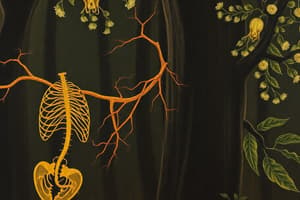Podcast
Questions and Answers
What functions does the parasympathetic nervous system primarily regulate?
What functions does the parasympathetic nervous system primarily regulate?
- Inhibiting digestion and nutrient absorption
- Slowing down the body's functions when at rest (correct)
- Increasing heart rate and energy usage
- Preparing the body for action
Which division of the autonomic nervous system is responsible for preparing the body for action?
Which division of the autonomic nervous system is responsible for preparing the body for action?
- Sympathetic nervous system (SNS) (correct)
- Peripheral nervous system (PNS)
- Central nervous system (CNS)
- Parasympathetic nervous system (PNS)
When is the parasympathetic nervous system primarily active?
When is the parasympathetic nervous system primarily active?
- During sleep and inactivity (correct)
- During physical and emotional stress
- During conscious control
- During intense physical activity
What is the main function of the autonomic nervous system?
What is the main function of the autonomic nervous system?
What are the effects of the sympathetic nervous system (SNS) when activated?
What are the effects of the sympathetic nervous system (SNS) when activated?
Which neurotransmitters are important for the autonomic nervous system (ANS)?
Which neurotransmitters are important for the autonomic nervous system (ANS)?
What is the role of neurotransmitters in the autonomic nervous system (ANS)?
What is the role of neurotransmitters in the autonomic nervous system (ANS)?
What is the fight or flight response?
What is the fight or flight response?
What happens to the body during the fight or flight response?
What happens to the body during the fight or flight response?
What is the function of the parasympathetic nervous system (PNS) when inhibited by the sympathetic nervous system (SNS)?
What is the function of the parasympathetic nervous system (PNS) when inhibited by the sympathetic nervous system (SNS)?
Study Notes
Autonomic Nervous System
The autonomic nervous system (ANS) is a part of the peripheral nervous system that helps regulate the body's internal environment to maintain homeostasis. This system is responsible for controlling functions that are not consciously controlled, such as heart rate, digestion, and breathing.
The ANS has two main divisions: the sympathetic nervous system (SNS) and the parasympathetic nervous system (PNS). These divisions work together to maintain a balance between the body's energy usage and energy storage.
Parasympathetic Nervous System
The parasympathetic nervous system is responsible for slowing down the body's functions when it is at rest. This system is primarily active during sleep and inactivity.
- Activation: The PNS is activated by the brain when it receives information that the body is at rest and does not need to be active.
- Effects: When the PNS is activated, it slows down the heart rate, increases digestion, and helps the body absorb more nutrients.
- Inhibition: The PNS also inhibits the activity of the SNS, which allows the body to relax and conserve energy.
Sympathetic Nervous System
The sympathetic nervous system is responsible for preparing the body for action. This system is active during physical and emotional stress.
- Activation: The SNS is activated by the brain when it receives information that the body needs to be active.
- Effects: When the SNS is activated, it speeds up the heart rate, decreases digestion, and prepares the body for action.
- Inhibition: The SNS also inhibits the activity of the PNS, which allows the body to use more energy.
Neurotransmitters
Neurotransmitters are chemical messengers that transmit signals from one neuron to another. These chemicals help control and coordinate the activity of the nervous system.
- Types: There are many different neurotransmitters, but some of the most important ones for the ANS include acetylcholine and norepinephrine.
- Role: Neurotransmitters play a crucial role in the function of the ANS, as they help regulate the balance between the SNS and PNS.
Fight or Flight Response
The fight or flight response is a physiological reaction that occurs when the body perceives a threat. This response is a combination of the activation of the SNS and the inhibition of the PNS.
- Activation: The SNS is activated, which speeds up the heart rate and prepares the body for action.
- Inhibition: The PNS is inhibited, which slows down the body's functions and conserves energy.
- Effects: The fight or flight response helps the body respond to a threat by increasing its energy and readiness for action.
Conclusion
The autonomic nervous system plays a crucial role in maintaining the body's internal environment and regulating its functions. The balance between the sympathetic and parasympathetic nervous systems, as well as the role of neurotransmitters and the fight or flight response, are all important components of this system. By understanding the ANS and its subtopics, we can gain a deeper understanding of how our bodies function and how they respond to various stimuli.
Studying That Suits You
Use AI to generate personalized quizzes and flashcards to suit your learning preferences.
Description
This quiz covers the autonomic nervous system (ANS), its main divisions - the sympathetic and parasympathetic nervous systems, the role of neurotransmitters, and the fight or flight response. Understanding these topics is essential for comprehending how the body maintains homeostasis and responds to stimuli.




